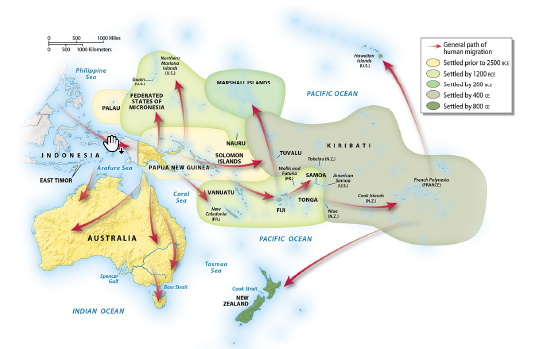Describe the population patterns and movements of Australia from aboriginal times to the present.

The large islands of New Guinea and Australia, with their nearness to the Asian landmass, were settled much earlier than the more distant islands of the Pacific. By 60,000 years ago, the ancestors of today's native Australian, or Aborigine, population were making their way out of Southeast Asia and into Australia. The first Australians most likely arrived using some kind of watercraft, but because such boats were probably not capable of more lengthy voyages, the more distant islands remained inaccessible to settlement for tens of thousands of years. During the last glacial period, however, sea levels were much lower than they are now, which would have allowed easier movement to Australia across relatively narrow spans of water from what is now Southeast Asia. It is not known whether the original Australians arrived in one wave of people or in many, but the available evidence suggests that they soon occupied large portions of the continent, including Tasmania, which was at that time connected to the mainland by a land bridge because of the lower sea level. Eastern Melanesia was settled much later than Australia and New Guinea. By 3500 years ago, some Pacific peoples had mastered long-distance sailing and navigation, which eventually opened the entire oceanic realm to human habitation. In that era, people gradually moved east to occupy New Caledonia, the Fiji Islands, and Samoa. From there, later movements took seafaring folk north into Micronesia, with the Marshall Islands occupied around 2000 years ago. Continuing movements from Asia further complicated the story of these migrating Melanesians. Some of the migrants mixed culturally and eventually
reached western Polynesia, where they formed the core population of the Polynesian people. By 800 CE, they had reached such distant places as Tahiti, Hawaii, and Easter Island. Prehistorians hypothesize that population pressures may have quickly reached crisis stage on the relatively small islands, leading people to attempt dangerous voyages to colonize other Pacific islands. Equipped with sturdy outrigger sailing vessels and ample supplies of food, the Polynesians were able to colonize most of the islands they discovered.
You might also like to view...
The land area from which surface water drains into rivers, lakes, and wetlands, is known as its ____________________.
Fill in the blank(s) with the appropriate word(s).
Intense solar heating of the surface may trigger a(n) ____________________ thunderstorm
Fill in the blank(s) with correct word
Biome description
What will be an ideal response?
The Cascade Range volcanoes
A. are now expected to become extinct as they cool. B. pose little threat, as their eruptions are typically quiet ones. C. sit above a subduction zone. D. All of the choices are correct.